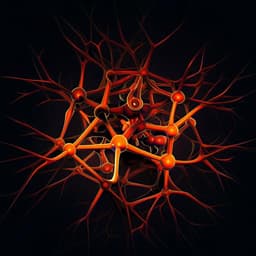
Medicine and Health
Differences in regional brain structure in toddlers with autism are related to future language outcomes
K. Duan, L. Eyler, et al.
Discover how early brain alterations in autistic toddlers can predict future language abilities, uncovering a complex interplay between brain structure and autism symptoms. This groundbreaking research was conducted by Kuaikuai Duan and colleagues at the Autism Center of Excellence, University of California, San Diego.
~3 min • Beginner • English
Introduction
The study addresses why language outcomes in autism spectrum disorder (ASD) toddlers are heterogeneous and difficult to predict from early clinical measures alone. ASD is highly prevalent and clinically heterogeneous, with some toddlers showing improvement in language and social domains over time while others remain minimally verbal. Prior work suggests early brain overgrowth and regional cortical abnormalities, particularly in temporal and frontal regions, may underpin core ASD symptoms and outcomes, but comprehensive, regional, multimorphometry analyses at the age of first detection are scarce. The authors aim to (1) identify early regional structural brain alterations in ASD toddlers while controlling for global brain size, (2) replicate these findings in an independent cohort, (3) test whether these anatomical features improve prediction of language outcome beyond clinical and demographic variables, and (4) examine associations between regional anatomy (temporal, fusiform, inferior frontal) and early symptom severity and cognition.
Literature Review
Prior neuroanatomical studies report early brain/cortical overgrowth in ASD, especially in frontal and temporal lobes, and functional abnormalities in temporal and fusiform regions implicated in social language and face processing. Findings in non-cortical structures (amygdala, corpus callosum, cerebellum) have been inconsistent, potentially due to cohort and methodological differences. Genetic and transcriptomic evidence indicates atypical prenatal cortical regional patterning and widespread dysregulation of thousands of genes, especially in temporal cortex, suggesting regional diversity in volume, surface area (SA), and cortical thickness. SA and thickness have dissociable genetic and developmental determinants, motivating simultaneous examination. Prior imaging studies linked temporal and fusiform alterations to social-communication deficits and face processing impairments, but mostly in older samples and cross-sectional designs. A previous study in toddlers linked atypical genomic cortical patterning to cortical enlargement and poor language outcomes. Together, literature supports investigating regional multimorphometry in toddlers and its relation to symptoms and language.
Methodology
Design: Longitudinal structural MRI (sMRI) study with replication, combined with prognostic modeling and brain–behavior correlation analyses.
Participants (main sample): 275 toddlers (166 ASD, 109 typically developing [TD]; 202 male, 73 female; mean age ≈ 2.21 ± 0.76 years) contributing 372 quality-controlled scans (initial and follow-up). Clinical assessments at intake and follow-up included ADOS (Modules T/1/2), Mullen Scales of Early Learning (ELC and subscales; ratio scores for subscales computed as age-equivalent/chronological age), and Vineland Adaptive Behavior Scales. Diagnosis used DSM-IV/V criteria in conjunction with ADOS by licensed psychologists.
Replication sample: 75 toddlers (38 ASD, 37 TD; 55 male, 20 female), 167 scans, collected 1–5 years old at same site with comparable procedures.
MRI acquisition: Main sample scanned during natural sleep on 1.5 T GE scanner with T1-weighted IR-FSPGR (TE 2.8 ms, TR 6.5 ms, flip 12°, bandwidth 31.25 kHz, FOV 24 cm, slice thickness 1.2 mm). Replication on 1.5 T Siemens Symphony during natural sleep.
Preprocessing: FreeSurfer 5.3 (Desikan–Killiany atlas) to derive global and regional morphometry (cortical volume, SA, thickness; subcortical volumes; eTIV). Quality control by two independent raters (0–3 scale); 75/447 scans excluded; inter-rater reliability ICC ≈ 0.64.
Statistical analyses (ASD vs TD): Linear mixed-effects models (LMEMs) tested diagnostic differences in global measures (eTIV, total cortical volume/SA, mean thickness) with fixed effects of diagnosis, scan age, sex; random intercept and age slope per subject. For regional measures, LMEMs included fixed effects diagnosis, scan age, sex, and relevant global covariate (eTIV for volumes; total cortical SA for regional SA; mean cortical thickness for regional thickness) plus random intercept/slope. Multiple comparisons controlled by FDR p < 0.05 across 204 cortical tests (68 regions × 3 morphometries) and separately for subcortical, cerebellar (LH/RH), and corpus callosum (CC) regions. Quadratic age term tested in sensitivity analyses. Sex-stratified analyses and analyses restricted to initial scans were also performed.
Prognostic modeling: Support vector machine (linear with ridge regularization). Outcome stratification at ~6-month follow-up: ASD Low if both Mullen EL and RL T < 40; ASD Low/Average otherwise. Features: (1) clinical/demographic-only (ADOS, Mullen, Vineland at intake; sex; intake age; interval to outcome), (2) sMRI-only (age- and sex-adjusted regional measures showing ASD vs TD differences), and (3) combined clinical/demographic + sMRI. Data scaled 0–1. Train/validation: 80% training with 5-fold CV; 20% hold-out test. Metrics: accuracy, sensitivity (ASD Low), specificity (ASD Low/Average), AUC. Stability assessed by 100 iterations of 5-fold CV.
Brain–behavior associations: Linear regressions relating intake regional morphometry (temporal, fusiform, inferior frontal regions and selected non-cortical structures) to intake ADOS (SA, total), Mullen (ELC, EL, RL, VR), and Vineland (ABC, Daily Living), controlling for age and sex. FDR correction applied within cortical and non-cortical sets.
Key Findings
Global measures: In the main sample, no significant ASD vs TD differences in eTIV (p = 0.96), total cortical volume (p = 0.07), total cortical SA (p = 0.49), or mean cortical thickness (p = 0.47). ASD Low subtype showed larger total cortical volume vs TD (p = 2.56×10⁻³, d = 0.39). In replication, ASD had larger eTIV (p = 0.02, d = 0.45), total cortical volume (p = 2.22×10⁻³, d = 0.58), and mean cortical thickness (p = 1.20×10⁻⁴, d = 0.77).
Regional cortical volume (main sample): Increased GMV in LH fusiform (p = 2.23×10⁻³, d = 0.42), LH middle temporal (p = 9.09×10⁻⁴, d = 0.38), RH middle temporal (p = 2.87×10⁻⁵, d = 0.49); decreased GMV in RH caudal anterior cingulate (p = 7.07×10⁻⁴, d = -0.39). Replicated: LH fusiform (p = 9.53×10⁻³, d = 0.52), LH middle temporal (p = 1.55×10⁻⁷, d = 0.97), RH middle temporal (p = 1.87×10⁻⁶, d = 0.70).
Cortical thickness (main sample): Thicker LH superior temporal (p = 1.05×10⁻⁵, d ≈ 0.45; beta = 5.24×10⁻³) and RH bank of STS (p = 1.49×10⁻³, d = 0.37); thinner LH pars opercularis (p = 1.68×10⁻³, d = -0.36) and RH pars opercularis (p = 2.76×10⁻³, d = -0.43). Replicated: thicker LH superior temporal (p = 3.02×10⁻⁷, d = 1.02), thicker RH bank STS (p = 0.05, d = 0.37), thinner LH pars opercularis (p = 5.33×10⁻³, d = -0.51).
Cortical surface area (main sample): Reduced SA in RH caudal anterior cingulate (p = 3.99×10⁻⁵, d = -0.48), RH medial orbitofrontal (p = 2.46×10⁻⁴, d = -0.50), RH posterior cingulate (p = 1.01×10⁻³, d = -0.39). Not replicated (p > 0.05 in replication).
Non-cortical volumes (main sample): Increased volumes in posterior CC (p = 1.23×10⁻³, d = 0.38), mid posterior CC (p = 1.58×10⁻², d = 0.28), mid anterior CC (p = 7.32×10⁻³, d = 0.31), anterior CC (p = 2.73×10⁻², d = 0.26); decreased right cerebellum cortex volume (p = 9.39×10⁻³, d = -0.30). Replicated: CC subregions (mid anterior, mid posterior, anterior) increased; right cerebellum decreased.
Sex-stratified analyses: Several differences (e.g., cerebellum, posterior CC, LH fusiform, LH/RH middle temporal, RH caudal anterior cingulate SA; RH pars opercularis thickness) present in both males and females; additional differences mainly in males.
Prediction of language outcome (ASD Low vs ASD Low/Average): On hold-out test set, clinical/demographic-only model accuracy 70% (AUC 69%; sensitivity 78%; specificity 60); sMRI-only 60% (AUC 60; sensitivity 67; specificity 52); combined clinical/demographic + sMRI 79% (AUC 79; sensitivity 78; specificity 80). Cross-validation iterations frequently yielded AUC ≈ 80% and accuracy ≈ 79%.
Brain–behavior associations (ASD toddlers): Larger LH fusiform GMV associated with higher ADOS total (r = 0.17, p = 2.62×10⁻²) and lower Mullen ELC (r = -0.25, p = 1.51×10⁻³), RL ratio, and VR ratio. Larger LH and RH middle temporal GMV associated with higher ADOS SA and total (r ≈ 0.24, p ≤ ~2×10⁻³) and lower Mullen ELC, RL ratio, and VR ratio (|r| ≈ 0.18–0.20, p ≤ ~0.02). Larger SA in RH caudal anterior cingulate related to lower Mullen RL ratio. Non-cortical: Larger posterior CC and mid anterior CC volumes related to lower Mullen RL ratio; larger right cerebellum cortex volume related to higher Vineland ABC (r = 0.23, p = 3.45×10⁻³) and Daily Living (r = 0.32, p = 4.93×10⁻⁴).
Discussion
Findings reveal a reproducible pattern of early regional brain morphometry differences in ASD toddlers, predominantly in regions subserving language, social cognition, and face processing (lateral temporal cortex, fusiform gyrus, bank of STS) and control/communication structures (inferior frontal pars opercularis, cingulate cortex, corpus callosum, cerebellum). After adjusting for global brain size, ASD toddlers showed larger/thicker temporal and fusiform regions, smaller/thinner inferior frontal and midline structures, larger corpus callosum subregions, and smaller cerebellum. These alterations replicated across cohorts for most GMV and thickness effects. Critically, morphometric abnormalities in temporal and fusiform cortex correlated with greater ASD symptom severity and poorer cognitive/language measures at intake, and inclusion of anatomical features improved prediction of language outcomes beyond clinical/demographic variables alone. Together, results support models of ASD involving dysregulated prenatal and early postnatal cortical regional growth, with dissociable alterations in SA and thickness. The robust thickening of LH superior temporal cortex in toddlerhood, consistent with literature in older ASD samples, suggests a key, developmentally persistent neural feature linked to atypical language network development. Alterations in CC and cerebellum align with early overgrowth and later maturational deviations implicated in ASD. Overall, the findings address the central question by linking early regional structural deviations to both concurrent symptom/cognitive profiles and near-term language prognosis.
Conclusion
This study demonstrates that ASD toddlers exhibit distinct regional brain morphometry differences—enlarged/thickened temporal and fusiform regions, thinner/smaller inferior frontal and midline cortices, increased corpus callosum subregion volumes, and reduced cerebellar volume—many of which replicate in an independent cohort. These early structural alterations correlate with symptom severity and cognitive performance and significantly enhance prediction of language outcomes when combined with intake clinical measures. The work highlights dysregulated regional cortical growth as a hallmark of early ASD and underscores the clinical utility of integrating sMRI with behavioral assessments for prognosis. Future work should validate findings in larger, closely age-matched samples, explore full feature sets with nested cross-validated models and alternative dimensionality reduction, and investigate mechanistic links between prenatal gene network dysregulation, cortical organoid phenotypes, and in vivo neuroanatomy and outcomes.
Limitations
- Feature selection for prognostic modeling was limited to regions showing ASD vs TD differences, potentially omitting other predictive features; more exhaustive feature selection with nested cross-validation is warranted.
- While many alterations replicated, surface area differences did not; larger replication cohorts and tighter age matching are needed.
- Group age differences (TD on average ~5 months younger) may leave residual developmental confounds despite covariate adjustment.
- Main and replication samples differed in size, age, and sex composition, potentially affecting replication power.
- ADOS-2 calibrated severity scores for the Toddler Module were unavailable; ADOS total was used instead, which may introduce minor comparability issues across modules.
- Class imbalance (more ASD Low than ASD Low/Average) and potentially stronger imaging signals in ASD Low may have favored sensitivity over specificity in sMRI-only models.
Related Publications
Explore these studies to deepen your understanding of the subject.







